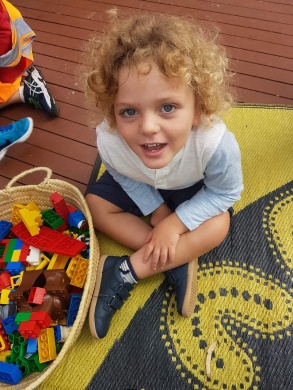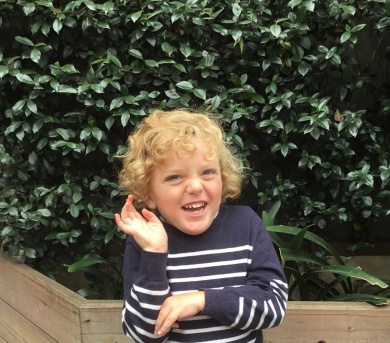Angus's Story
Family hopes for cure for neurological disorder
 David Hunter describes his little son, Angus, as a blonde cherub who is irrepressibly happy. But David fears that he will never hear Angus call him ‘Dad’ and his boy may not learn to walk. Angus has an extremely rare and little-understood genetic brain disorder called BPAN – beta-propeller protein-associated neurodegeneration.
David Hunter describes his little son, Angus, as a blonde cherub who is irrepressibly happy. But David fears that he will never hear Angus call him ‘Dad’ and his boy may not learn to walk. Angus has an extremely rare and little-understood genetic brain disorder called BPAN – beta-propeller protein-associated neurodegeneration.
David and his wife, Edwina, first became concerned something was wrong when Angus (born in 2014) began missing baby milestones, like rolling over and sitting.
Initially, BPAN appears as a developmental delay. The disorder interferes with normal childhood progress, so children with BPAN find it difficult to learn fine motor skills like rolling, crawling and walking. Many children with BPAN, including Angus, don’t acquire speech.
What frightens David most about Angus’s condition is that BPAN will one day, change gears and accelerate. If that day comes without a treatment, Angus will decline rapidly. He will lose every skill he has mastered, from sitting to eating and swallowing.
The race is on – a cure or treatment must be found for Angus and other children diagnosed with BPAN before they reach their late teens or early twenties, which is when the deterioration starts. The clock is ticking; that is why raising funds to support scientific research into BPAN is crucial.
Study to investigate the cause and search for potential treatments
Thanks to an anonymous donor, Murdoch Children’s Research Institute conducted research in 2019 into the cause of BPAN and searched for potential treatments.
The donation enabled Murdoch Children's to conduct the only research study into BPAN in Australia and one of very few around the world. The donation has also given David and Edwina hope for their son’s future.
BPAN is not an inherited condition, but a random genetic mutation. It stems from a fault in the gene WDR45 and results in a build-up of iron in the brain. That build-up then causes the problems. The study focused on iron accumulation, the area considered to be the best prospect for a cure.
BPAN was only identified by a team of American genomic researchers in 2013. Worldwide, around 125 children have now been diagnosed. In Australia, there are 11 people with BPAN ranging from toddlers to a 36-year-old woman. However, the number of children being detected with the neurodegenerative condition is rising steadily, mainly because it has become easier for clinicians to sequence the human genome, and more doctors are ordering genetic tests when baffled by mysterious childhood conditions.
Angus, who was featured in an ABC News story about BPAN in 2018, was two when he was finally diagnosed after his family was given several misdiagnoses along the way, including cerebral palsy. This complicated pathway to diagnosis is not uncommon for children with rare genetic disorders. An Australian study found that around one in three people with rare genetic conditions waited more than five years for a diagnosis. A similar number saw more than six doctors before a diagnosis and half had at least one incorrect diagnosis.
Diagnosis comes as a great shock and with mixed feelings
David said he and his wife suspected something was wrong with their son within the first year, but it was on a family holiday in Fiji when Angus was 13 months that the situation went truly awry.
Angus developed a high fever and began having seizures. His parents thought they were febrile convulsions, but seizures are another manifestation of BPAN. Angus was treated by a local Fijian team, supported by a holidaying Australian paediatrician. On their return to Australia, David and Edwina sought out a specialist in Melbourne, who then ordered genomic sequencing. Within 12 months, the family had an answer.
David said he had mixed feelings when his son was finally diagnosed with BPAN – “I guess I wanted to hear that there was some magic panacea that would make everything better, but there is not. I was shocked, and I think I will always be in shock.”
He admits to having ‘Why me, why us’ moments, which he resists, and explains the journey is made easier by his son’s relentless cheerfulness. “He is a beautiful, happy, happy boy. No matter what the circumstances he always manages to look on the bright side. No matter how many visits there are to the children’s hospital, he is always happy to a fault, and in some respects, it makes the burden on us easier, but also harder because we love him so much.
“Because he is nonverbal, he relies on other means of communication, subtle means of communication to engage people, he uses his eyes, his amazing smile, infectious laugh and facial expressions. Angus’s method of showing someone he wants a kiss is to open his mouth and it never ceases to amaze me how much interaction and how many kisses he gets, even from total strangers.
“I can’t stand the idea that unless a treatment is found there will come a time when Angus will deteriorate rapidly much like someone with Parkinson’s disease or dementia. I know this is coming, bearing down on us like a freight train unless we find out how to beat this condition.”
Motivated to make a difference and raise awareness
David explains that this has ultimately motivated him to become very active in raising awareness and support for BPAN research. “I am a fairly pragmatic, practical person and just could not stand by and hope that someone, somewhere else, was going to do something to help Angus and the other kids, so I am doing something practical to help Angus and others and us.”
He is also actively supporting the parents of other children with BPAN. There is an online community on Facebook and he corresponds with the other families. “A lot of people get in touch with me when they get their diagnosis and ask a lot of questions, and I remember that when we got our diagnosis, people helped me through Facebook. It was a reassuring hand on my shoulder.”
David says his schedule of medical and therapy appointments is almost a full-time job for him and his wife, and as Angus grows, it’s getting harder to get him in and out of the bath, bed and the car. David is still in regular contact with other parents, single parents and families in remote parts of Australia who are doing it even tougher.
David has faith that BPAN is a mystery Australia’s top medical minds can crack, though he is mindful that Angus and the other children need answers sooner rather than later. David knows this is why funds are needed to support BPAN research. “The other BPAN sufferers have begun to rapidly deteriorate in their late teens and early twenties. I can’t face the idea of my little boy going through that.”

